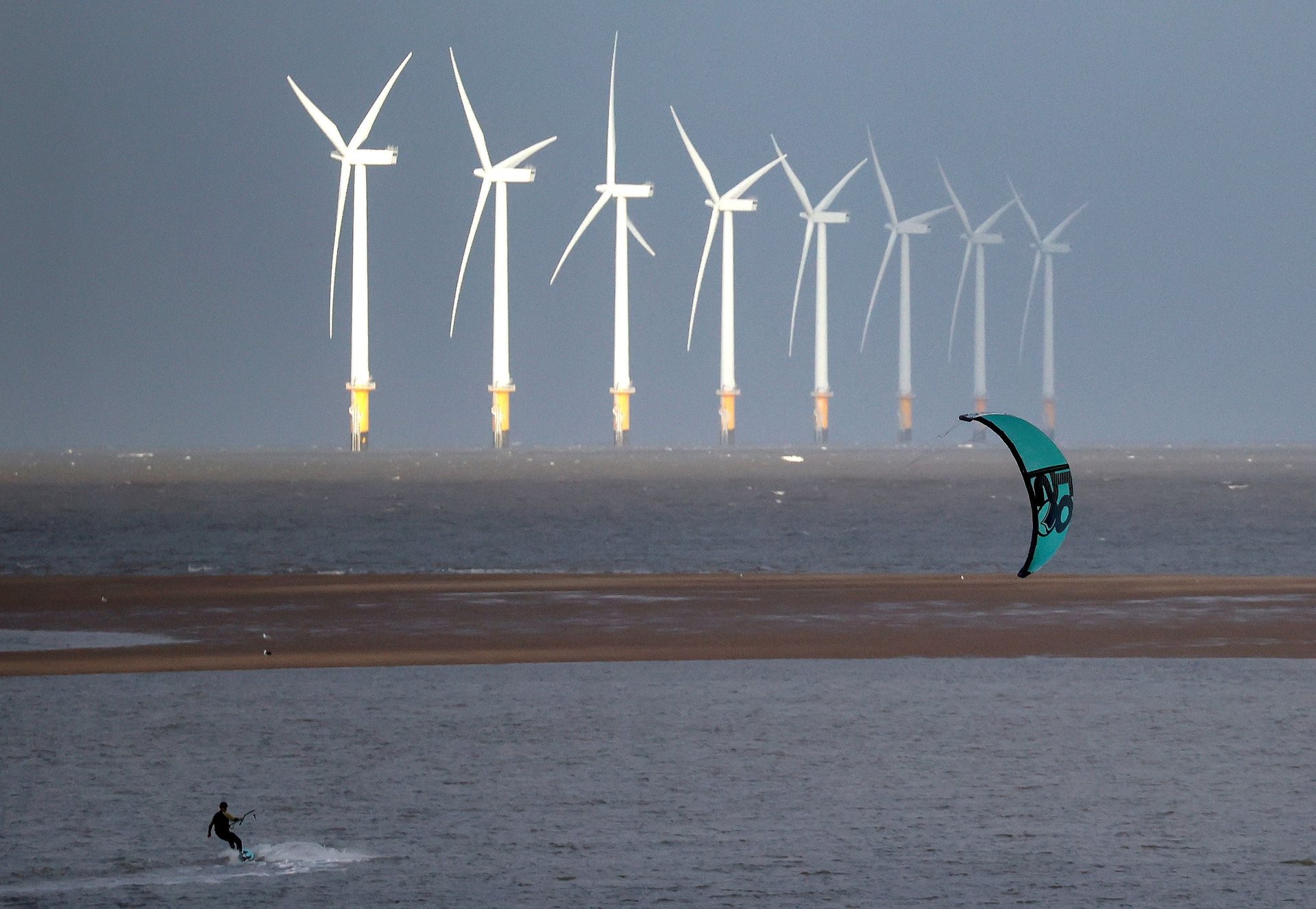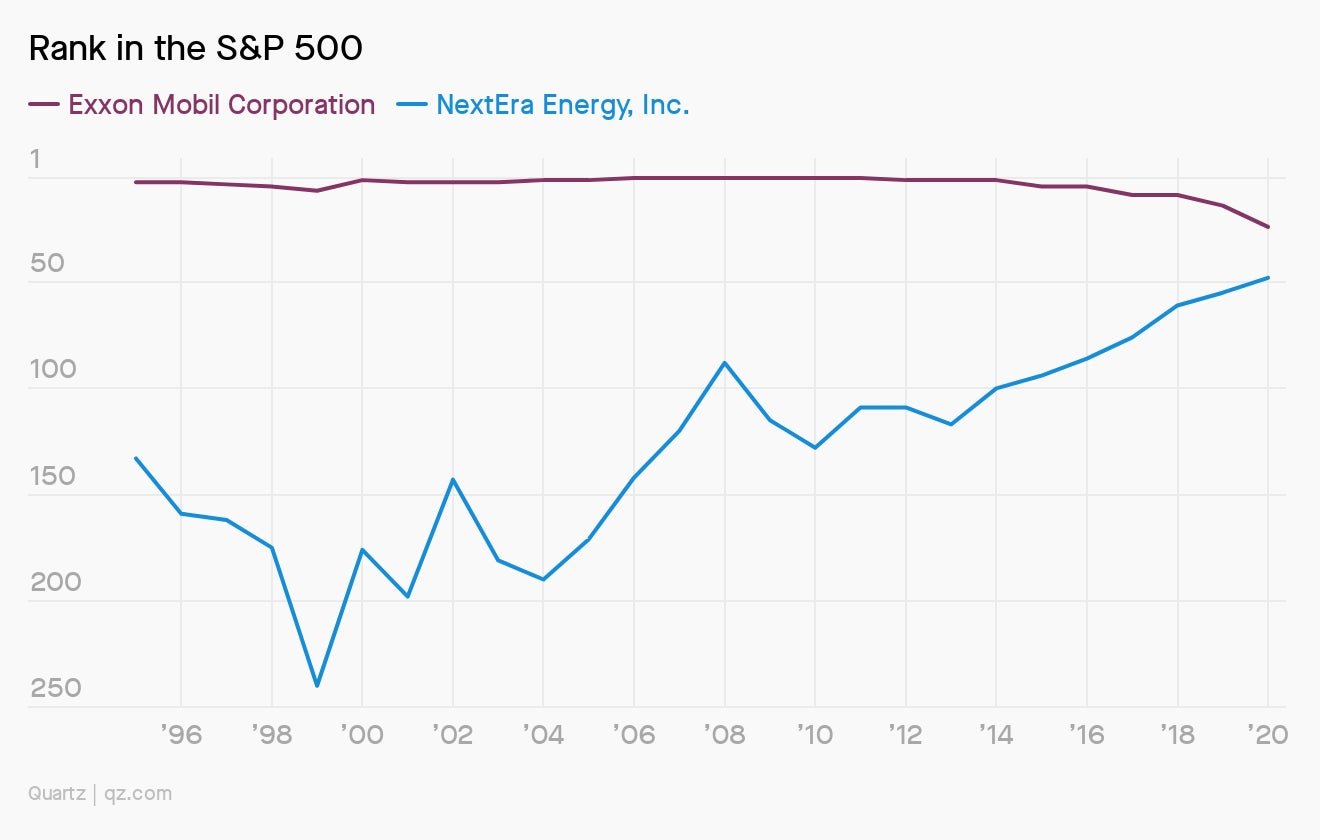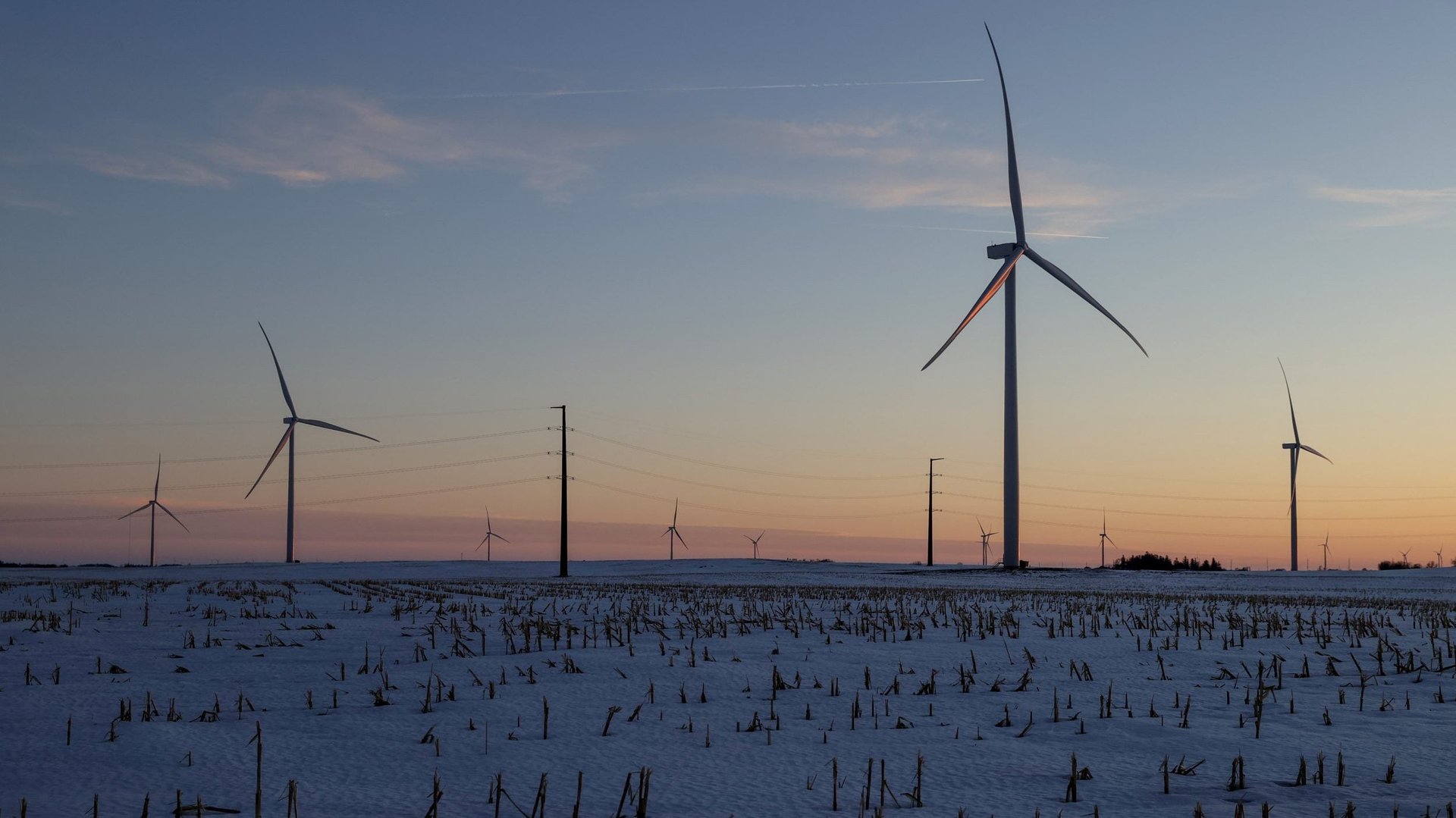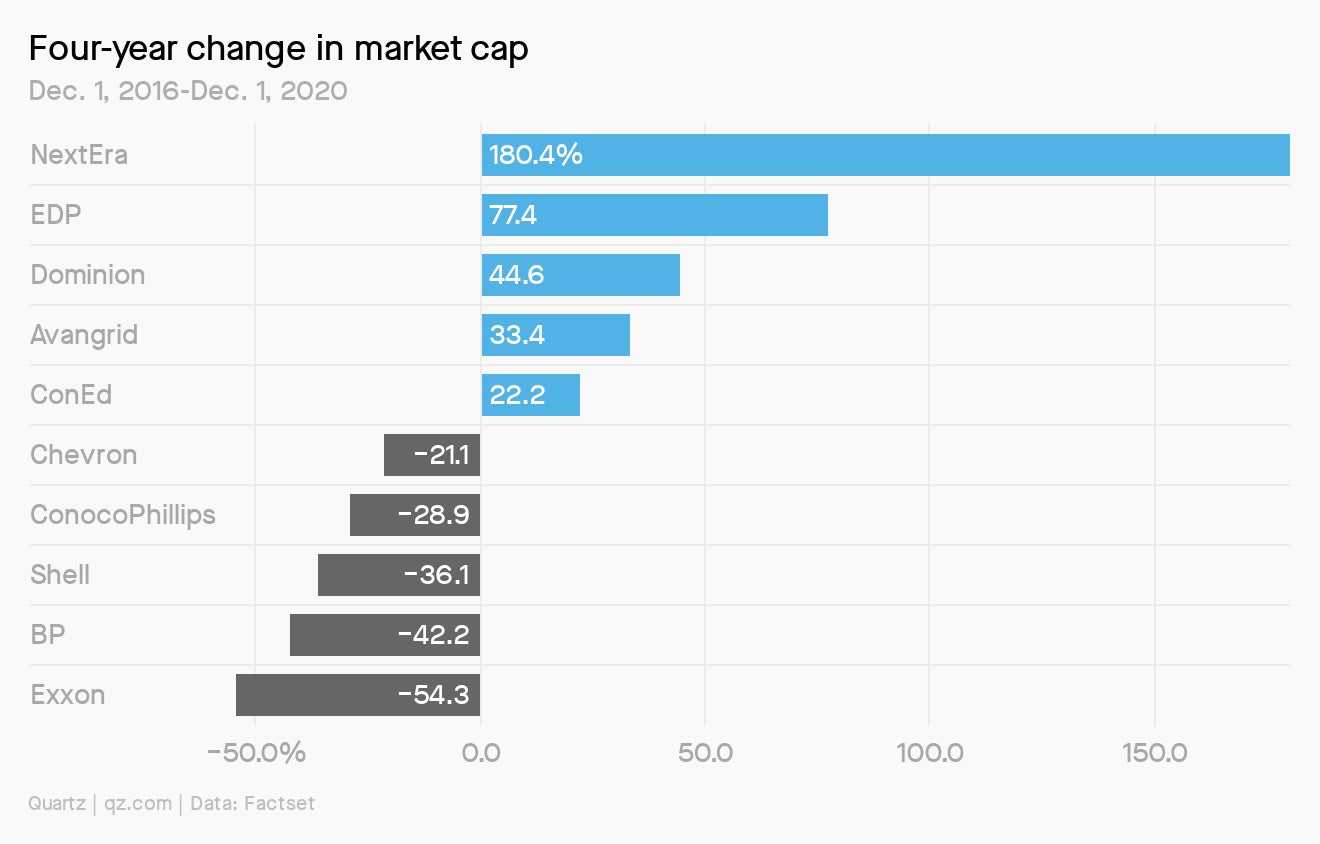For Quartz members—The company that unseated Exxon
Hi [%first_name | Quartz member%],


Hi [%first_name | Quartz member%],
Oil companies have always been the titans of the American energy industry. Now, their hegemony is being challenged by power companies focused on renewables—especially NextEra Energy. The 95-year-old outfit is the world’s biggest purveyor of wind and solar power, and it got there by leveraging its portfolio of fossil fuels.
But first, a recap: Vaccines rollout plans are getting clearer, Amazon is leapfrogging the world’s largest employers, and Topshop is the latest casualty in the mass culling of retailers. One of India’s Covid-19 vaccine contenders is embroiled in a legal battle, and workaholic Asia is trying the four-day work week. Will America’s millennials ever be as wealthy as Gen-X? We took a look.
Your most-read story this week: China’s “wolf warrior” art is getting a boost from its most fiery diplomat. And most relatable member goes to the watcher of Why do sharks bite people? There’s never a wrong time for deep-sea counter-programming.
Okay, now feel the wind in your hair and the sun on your face. We’re heading into the NextEra of renewable energy.
A tale of “two sports”
Today, wind and solar power account for less than 9% of US electricity. That may not seem like much, but in 2000 it was just 0.16%. Over those 20 years, no company built more US wind and solar farms than Florida-based NextEra Energy. The company now controls (pdf) more wind and solar than exists in all of Australia, and more than twice that of its nearest competitors.
That dominance is largely the product of the unique relationship between NextEra’s main subsidiaries. NextEra Energy Resources (NEER), a pioneering dealer in the thriving nationwide market for renewable wholesale power, gives the company a green shine. Florida Power & Light (FPL), the company’s real financial bedrock, is a natural-gas-reliant utility with a dubious environmental record. In the words of one industry attorney, this dynamic allows NextEra to be “very successful at playing two sports with completely different sets of rules.”
But building the world’s biggest fleet of wind and solar farms isn’t NextEra’s only feat. Shareholder returns are up 530% (pdf) over the past decade, more than double the S&P 500 and well above the utility industry average. In October, NextEra briefly topped Exxon as America’s biggest energy company, with a market value just above $150 billion. In the next few decades, the world will have an insatiable craving for zero-carbon electricity. NextEra has proven that there are piles of money to be made feeding it.
A brief history
1925: Florida Power & Light is founded. It sells electricity, ice cream, laundry services, and other odds and ends in the Miami area.
1950: FPL goes public (and goes on to reach 1 million customers by 1966).
1972: The company builds Florida’s first nuclear power plant, at Turkey Point. A marvel of engineering at the time, the plant gives the company nuclear experience that later proves valuable, but also draws fire for water pollution.
Early 1980s: The first large, modern-looking wind farms in the US crop up in Texas.
1992: George Bush signs the first-ever wind tax credits.
1996: FERC Order 888 creates brand-new markets for wholesale power in many states. FPL Energy, which would become NEER, is created to hunt for new profit opportunities outside Florida.
1998: The company builds its first wind farm, in Umatilla County, Oregon.
Early 2000s: A number of states begin to require utilities to purchase renewable energy, a lucrative opening for FPLE.
2003: FPLE owns nearly half of all wind power in the US.
2005: Earnings exceed $1 billion for the first time.
2008: The company takes its first steps abroad, with a wind farm in Quebec. A later foray into Spain is ultimately scrapped.
2009: FPLE becomes the world leader in wind and solar—a title it has held since—and changes its name to NextEra Energy Resources (NEER). The next year, the parent company changes its name from FPL Group to NextEra Energy.
2016: Next Era’s attempt to purchase a smaller utility in Hawaii is scuttled by officials there over concerns that the company isn’t serious enough about climate goals.
2017: FPL, the utility subsidiary, is called out by watchdog groups for manipulating Florida regulators and opposing environmental policy initiatives in the state. One former official says the company “acted like thugs.”
2020: NextEra spends $1.4 million on national political action committees, more than any other utility, of which 52% goes to Republican candidates.
2020: NEER has contracts booked to at least double its renewables portfolio, and to build a pilot hydrogen power facility.
Clash of the titans

By the digits
$146 billion: NextEra’s market cap as of Dec. 1, up 180% since 2016.
$3.7 billion: The company’s 2019 net income, of which 42% came from renewables-heavy subsidiary NEER.
13%: Share of total US wind capacity belonging to NEER, down from 47% at its peak in 2003.
119: Number of wind farms operated by the company today.
$122 billion: Value of all of NextEra’s assets, including wind, solar, natural gas, oil, coal, and nuclear power stations.
~75%: The share of Florida Power & Light electricity that comes from natural gas; also the share of NEER electricity that comes from wind and solar.
$8 million: Amount FPL contributed in 2016 to groups opposing a pro-solar ballot measure in Florida (which ultimately failed to pass).
15%: Annual increase in cost efficiency (electrons per dollar invested) of wind and solar since 2010.

How NextEra produces its electricity
💭 Natural gas: 46% of the portfolio. Gas, a fossil fuel responsible for CO2 and potent methane emissions, has long been the company’s mainstay and continues to provide the majority of power for FPL customers.
🌬️ Wind: 27%, all in the wholesale market outside of Florida. Spread across 119 farms, mostly in the Great Plains region, Texas, and California.
⚛️ Nuclear: 12%, including the Turkey Point plant near Miami that has come under scrutiny for leaking polluted water in Biscayne Bay. NextEra recently pushed federal regulators to approve an extension of the plant’s life.
☀️ Solar: 7.5%. That’s poised to at least double in the next few years as FPL, which up to now has been a laggard on renewables, completes the construction of dozens of new midsize solar farms.
🕳️ Coal: 5% from the most carbon-polluting energy source. This percentage jumped in 2019 when NextEra acquired Gulf Power, a smaller Florida utility that is mainly powered by coal.
🛢️Oil: 2%, mostly from a single plant in Maine.
🗑️ Landfill gas: <1%, from a facility near Pensacola.
New kids on the block
The market capitalizations of companies with leading renewable energy portfolios in the US (blue) are growing—NextEra more than any—while those of oil majors (gray) are contracting.

Keep reading:
- The US oil industry is flailing despite a $10 billion bailout.
- How the Covid-19 pandemic upended the oil industry’s century-old business model.
- A crackdown on methane, potent greenhouse gas, is coming soon, and US companies aren’t ready.
- Here’s what US president-elect Joe Biden can do on climate, even with a divided Senate.
- Nuclear energy plants are a key source of zero-carbon energy. In the US, they’re crumbling, while in China they are booming.
- Carbon capture could help polluting power plants cling to life—but the business model is broken.
One correction: In last week’s email on Instacart, we said Webvan blew through $800 billion in three years. That would be a feat. It was $800 million.
Thanks for reading! And don’t hesitate to reach out with comments, questions, or companies you want to know more about.
Best wishes for a meditative end to your week,